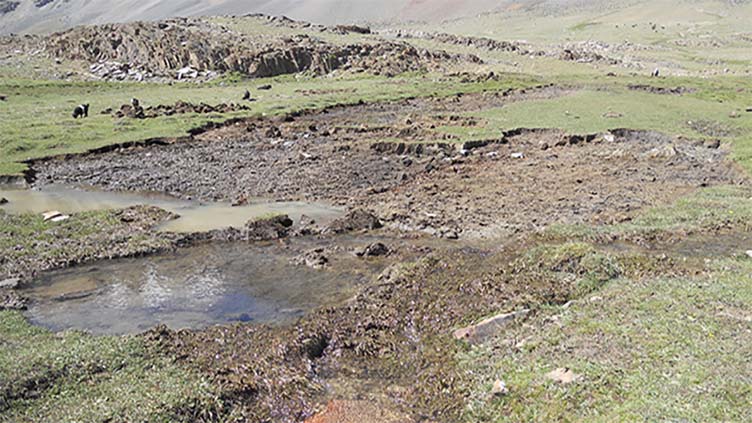Study calls for conservation of Broghil Valley peatlands

Pakistan
Study calls for conservation of Broghil Valley peatlands
PESHAWAR (APP) – A study on peatland consumption in Broghil National Park of Chitral has warned of over-extraction of natural resources, resulting in the shrinkage of grazing lands, degradation of wildlife habitat and an increase in fume emissions.
The study, conducted by two researchers, Khurshid Ali Shah and Hamid Ahmad, suggests holding detailed scientific research to obtain complete data on the available natural resources and prepare a strategy for ensuring sustainability.
“Peatlands are an important carbon store and contain up to one-third of the world’s terrestrial carbon pool,” says Hamid Ahmad, adding that these represent an important long-term sink for atmospheric carbon dioxide (CO2) and have the potential to moderate concentrations of atmospheric CO2.
The study was carried out in 12 villages in Broghil Valley that depend on peatlands to fulfill their energy and fodder needs.
The study objectives were also to know the existing status of the peatlands, assess trends in peatlands use, evaluate the usage and pressure on the peatlands, and formulate a long-term strategy for peatland conservation and management in the Park.
The biodiversity value of peatlands demands special consideration in conservation strategies and land use planning, Hamid stresses.
The exploitation of peat as a fuel for domestic use began around 75 years ago when locals came to know through a migrant from China that peat could be used as fuel. Since then, peat has been the traditional domestic fuel in Broghil Valley.
The peatlands also perform some crucial ecological roles like water storage, offering habitat for migratory birds, as a source of fodder for livestock and wildlife, and as the major carbon sink at that altitude.
Peatlands are sensitive to climate change. In the last 40 years, the peatlands ecosystem in Broghil Valley has been under tremendous pressure due to over-exploitation to meet household energy needs of the communities that live permanently at high altitudes, reads the study.
The interviews and informal discussions were conducted mostly with herders, farmers, peat block extractors, and village elites. Participatory Rural Appraisal/Participatory Learning and Action tools were also used to assess the situation in the area.
Information was collected on demography, education, socioeconomic factors, livestock holdings, peat utilisation and occupation, Hamid says.
During the study, it was found that some villages have already used 90 percent of their peat. If peat consumption continues at the present rate, it is estimated that in 20-30 years, all the peatlands will have become a wasteland, he warns.
Conservation of existing peatlands and restoration and rehabilitation of the degraded peatlands through community participation are important to minimize pressure. Broghil, he continues, is one of the most important valleys in the region by its strategic location; it borders the famous Wakhan Strip of Afghanistan and is connected to Afghanistan in the northwest via the famous Broghil Pass and Darwaza. It has several peatland areas.
The valley is rich in medicinal plant resources and has more than 80 medicinal plant species. However, the local people cannot identify, process and market these valuable plant species. The alpine pastures and rocky slopes are interspersed with wetlands and provide a congenial habitat for many mammals, some endangered, such as snow leopard (Panthera uncia), Himalayan ibex (Capra sibirica), brown bear (Ursus arctos), blue sheep (Pseudois nayaur), wolf (Canis lupus), red fox (Vulpes), golden marmot (Marmota caudata), and lynx (Felis lynx).
The valley is of global importance as it is the gateway of the Indus flyway to South Asia.
WWF-Pakistan and the Pakistan Wetlands Programme identified a total of 83 species of birds in 30 families and 13 orders in the Broghil Valley.
Broghil Valley is characterised by the presence of more than 30 small and large lakes, peatlands areas, Broghil River and glaciers.
The valley has tremendous potential for ecotourism. There are famous historical passes towards Gilgit-Baltistan and neighboring Afghanistan, which leads to Tajikistan and China.
Some of the villages in Broghil Valley, including Chikar and Iskarwaz, have extracted almost 90 percent of their share of the communal peatlands. Now, these villages are fulfilling their fuel requirements from government-owned peatland areas.
Seasonal trends in peat use vary considerably. During summer (May to September), the daily consumption of peat per household is around 100-150 kg, while in winter, this jumps to 200-300 kg.
In summer, household energy requirements are supplemented through other means, eg, fuel-wood, animal dung and agricultural residues. But in winter, heavy snowfall and low temperatures impair the mobility of local communities and people remain confined to their houses. This increases energy demand, which is often met by burning peat. The use of peat varies from hamlet to hamlet within the valley.
Excessive utilisation of peatlands is leading to the loss of habitat for key wildlife species, a decline in both covered area and productivity of grazing lands, enhanced emission of greenhouse gases (GHGs), and increased respiratory problems within the human population as a result of using peat as a source of domestic energy.
According to one estimate, if peat consumption continues at the present rate, in 20-30 years, all the peatlands will be severely degraded, adds the study.
The study recommended the restoration of degraded peatlands through community mobilisation, conservation of the existing meager peatland resources through collaborative methods, development of a proper mechanism for marketing resources, including medicinal plants, livestock byproducts and gemstones to supplement income.
There is also a need to identify and introduce alternative sources of fuel to reduce the pressure on the threatened peatlands and design proper fuel-efficient stoves in consultation with local communities to minimise the daily use of peat.
It also suggested developing a complete database on available natural resources, CO2 emissions, carbon stocking rate, biodiversity value and developing a peatland/rangeland/pasture management plan. The plan should be implemented by involving the local community at the grassroots level and by considering the options for this community to benefit by linking the peatlands with the REDD+ mechanism.


